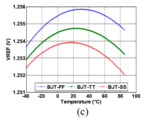gn7623233
Newbie level 6
Hi,
I have designed a bandgap, it works fine.
And different corners have different curvature.
One thing i wanna know is :
Why FF (SS) corner has larger (lower) voltage than TT corner at the same temperature.
Just like the figure 5.(C) https://reurl.cc/j741dn
Is it about the doping concentration influence the saturation current (Is) or other factor?
THANKS!
I have designed a bandgap, it works fine.
And different corners have different curvature.
One thing i wanna know is :
Why FF (SS) corner has larger (lower) voltage than TT corner at the same temperature.
Just like the figure 5.(C) https://reurl.cc/j741dn
Is it about the doping concentration influence the saturation current (Is) or other factor?
THANKS!
